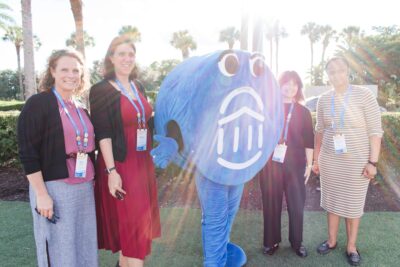How will agentic AI show up in higher education?
While higher education continues to come to terms with generative AI, a new buzzword is beginning to capture imaginations: agentic AI. Gartner named agentic AI the top tech trend of 2025 and forecasts that by 2028, 33% of enterprise software applications will include it. But what is agentic AI? When and how will agentic AI show up on campus?
In this blog post, I’ll draw from my work on EAB’s IT Strategy Advisory Services team to define agentic AI and explore how it will reshape AI applications in higher education.
Defining agentic AI
Agentic AI systems use AI agents (often teams using generative AI) to take proactive action within predefined limits, without requiring human prompting at every step. They can iterate and experiment to achieve goals and tasks, even in unclear scenarios. With knowledge and memory recall, they can learn and improve from past experiences. These systems also regularly combine multiple AI models, optimizing them for certain tasks.
Agentic AI builds on generative AI, often leveraging teams of agents using generative AI to execute more complex tasks across administration and academia. Almost three years since generative AI emerged, most applications are still a far cry from the autonomous coworker or across-the-lifecycle tutor initially touted. Today, higher education is most likely to have deployed AI applications that retrieve information to support small-scale decision-making (e.g., an HR policy chatbot). Agentic AI not only optimizes existing generative AI use cases but also expands the scope of what they can achieve. This progression is already evident in applications out-of-sector. Early coding assistants like Github Copilot generated code and enhanced developer productivity, but they did not think through application development. With the advent of agentic AI, Cognition Labs recently deployed the software engineer assistant, Devin, who can write code as well as debug and deploy entire applications autonomously
In higher ed, agentic AI can enable AI tutors that can not only recall course information but also troubleshoot learning challenges more effectively and reach out to advisors on a student’s behalf.
Here are three examples of generative AI applications are already evolving on campus due to agentic AI:
How campus stakeholders will begin engaging with agentic AI
Faculty, staff, and students will encounter and adopt agentic AI in distinct ways. Here’s how we think agentic AI will begin impacting these different groups:
1. Faculty and staff will access agentic AI at scale through enterprise software applications (e.g., M365 Copilot)
Mainstay vendors like Microsoft are already beginning to integrate agentic AI capabilities within their products. In March 2025, it announced two new deep-reasoning agents embedded in Microsoft 365 Copilot. Microsoft’s Research and Analyst agents can access work data from platforms like Salesforce and ServiceNow to support in-depth research and reporting. For example, the Analyst agent is positioned as an expert data scientist, able to analyze raw data, write Python code, and generate full reports like revenue projections autonomously.
See more examples of how more enterprise applications are incorporating agentic AI:
| Vendor | Agenic AI feature | Sample use case |
|---|---|---|
| Workday | Role-based AI agents in areas such as payroll, financial auditing, and policy that can be configured to support role-specific tasks. | Role-based AI agents in areas such as payroll, financial auditing, and policy that can be configured to support role-specific tasks. |
| Box | AI agents designed to streamline document navigation include a search, deep research, enhanced data extraction, and Microsoft 365 Copilot and chat agent. | A legal team could use the Box AI agents to examine indemnification clauses across enterprise contracts, report on trends and outliers, automatically classify contracts, and update file metadata accordingly. |
| Navigate360 | AI agents across the student lifecycle, from course planning, reporting, to marketing campaign agents. |
Enrollment marketing staff can use campaign agents to analyze historical data, identify prospective students with a high likelihood of enrolling, and create hyper-personalized communications directed at them. Once enrolled, faculty and staff will be able to anticipate prospective student concerns based on their profile history and monitor ongoing holistic performance with the student insights agent. |
| Amazon | Amazon Q is an agentic AI assistant that is being rolled out across Amazon products. |
In Amazon Q Business, users can use Q to build apps to automate workflows and tasks like drafting emails from notes and updating associated records. In Amazon Connect, the cloud contact center, Q can detect customer issues, respond automatically, and provide recommended actions. |
2. Administrative staff will automate repetitive processes (e.g., procurement and IT ticket routing) because agentic AI reduces implementation barriers
While agentic AI significantly expands what can be automated effectively, it is still best suited for structured, well-defined workflows. Compared to earlier automation technologies like machine learning and robotic process automation, deploying agentic AI typically requires less manual configuration and oversight for similar use cases. And as vendors rush to integrate agentic AI, conditions are ripe for scaling automation. For higher education staff, this offers the opportunity to offload rote work and decision-making, leaving more time for them to focus on higher-order decision-making.
Vendor solutions are already emerging. In IT, ServiceNow agents can now detect server problems, propose resolutions, execute fixes, and even review results while keeping staff informed throughout the process. Similarly, ServiceNow’s HR agents can guide new staff through onboarding, identifying what they need, and automatically provisioning access after cross-referencing company policies. During any step in the process, agentic AI systems can directly raise issues with different stakeholders.
3. Students will incorporate agentic AI tools that traverse browsers and computer files into how they undertake schoolwork
Enterprising students will soon discover how much more they can accomplish with browser- and computer-using agents that can interact with the internet and their computer files and programs to achieve complex tasks. Manus AI is the latest highly publicized multi-agent system from China with free deep research capabilities. With Manus, a central taskmaster oversees different agents completing subsets of tasks and responsibilities, whether one is analyzing data or developing code. Domestically, OpenAI recently previewed its own research agent called Operator.
While a student might now prompt ChatGPT to draft their paper, they will soon be able to ask agentic AI tools to draft a research plan, test hypotheses, iterate on findings, and generate a research report—all with one prompt. The good news is that faculty have already begun designing AI-proof and AI-first assignments, but the urgency to do so has intensified with the emergence of agentic AI.
In conclusion
Amid all the hype, it can feel overwhelming to try to keep up with AI advancements lately. But agentic AI is worth digging into; its potential to power automations that take over rote work could transform the day-to-day experience of staff across your institution.
Whether you’re an AI front-runner or just beginning to develop your school’s approach to generative AI, EAB is here to help, and I’ll continue to share what I’m learning from colleges and universities embracing the transformative power of this fast-changing technology.

More Blogs

AI visibility is critical when competing for student enrollments

What changed in the graduate lead gen landscape in 2025
